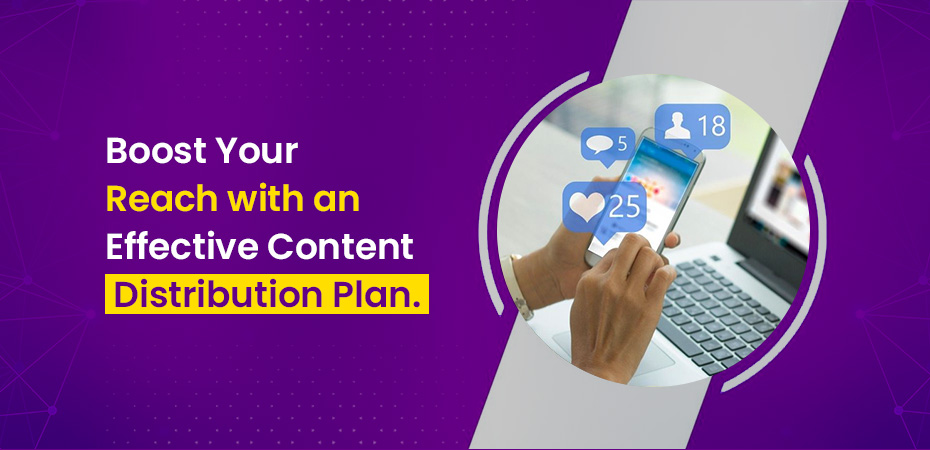Boost Your Reach with an Effective Content Distribution Plan



Have you ever wondered why some content goes viral while others barely get noticed? The secret lies in content distribution – the strategic process of sharing, publishing, and promoting your content across various digital channels.
Think of content distribution as your digital marketing megaphone. It’s not just about creating great content; it’s about making sure it reaches the right people at the right time. A solid distribution strategy for marketing can:
- Amplify your brand’s voice across multiple platforms
- Connect with your target audience where they spend time
- Drive meaningful engagement and conversions
- Maximize your content’s ROI
Ready to transform your content’s reach? This guide will walk you through:
- Building a robust content distribution framework
- Selecting the perfect channels for your audience
- Creating a practical distribution calendar
- Measuring and optimizing your strategy’s performance
Let’s unlock the power of strategic content distribution and give your digital marketing efforts the boost they deserve.
Understanding Content Distribution
Content distribution is your strategic approach to sharing, promoting, and amplifying content across multiple platforms and channels. Content distribution includes selecting the right content channels to reach your target audience effectively. Think of it as a delivery system that ensures your valuable content reaches the right people at the right time.
Brand visibility thrives on effective content distribution. Here’s why it matters:
- Expanded Reach: Your content breaks through geographical barriers
- Enhanced Credibility: Regular presence builds trust with your audience
- Increased Engagement: Multiple touchpoints create more opportunities for interaction
- Better ROI: Strategic distribution maximizes your content investment
Content distribution operates through three main media types:
- Owned Media: Your website and blog, social media profiles, email newsletters, and mobile apps
- Earned Media: Customer reviews, social shares and mentions, press coverage, and word-of-mouth recommendations
- Paid Media: Social media advertising, pay-per-click campaigns, display ads, and influencer partnerships
Each media type plays a unique role in your distribution strategy. Owned media gives you complete control, earned media builds credibility through third-party validation, and paid media accelerates reach through targeted promotion.
A successful distribution strategy often combines these three media types to create a comprehensive approach that maximizes content visibility and impact.
The Role of Content Distribution in Digital Marketing
Content distribution is a powerful tool that can drive your digital marketing success. It serves as a bridge, connecting your amazing content with the right people at the right time.
Here’s how content distribution enhances your digital marketing:
- Amplifies Marketing Messages: Your content reaches wider audiences across multiple touchpoints, creating a consistent brand presence
- Boosts SEO Performance: Strategic distribution on relevant platforms generates quality backlinks and increases organic visibility
- Drives Targeted Traffic: Sharing content on platforms where your audience hangs out brings qualified visitors to your website
- Nurtures Lead Generation: Regular content distribution keeps your brand top-of-mind throughout the customer journey
How to Align Content Distribution with Your Marketing Goals
To ensure that your content distribution efforts align with your marketing goals, consider the following strategies:
Map Content to Customer Journey Stages
- Awareness: Share educational blog posts and infographics
- Consideration: Distribute case studies and comparison guides
- Decision: Push product demos and customer testimonials
Match Distribution Channels to Goals
- Increase Brand Awareness: Focus on social media and PR
- Generate Leads: Prioritize email marketing for content distribution and use gated content
- Sales: Target paid advertising and retargeting campaigns for content distribution
Remember to track your distribution efforts against specific marketing KPIs to measure impact and adjust strategies accordingly.
Setting Measurable Goals for Your Content Distribution Strategy
Creating measurable content marketing and distribution goals helps track your distribution strategy’s success. Let’s break down specific objectives for each stage of the buying funnel:
Awareness Stage Goals:
- Website traffic growth rate
- New visitor percentage
- Social media reach and impressions
- Content downloads
- Blog post views
Consideration Stage Goals:
- Average time spent on page
- Pages per session
- Social media engagement rates
- Email open rates
- Newsletter subscription rate
- Comment engagement
Decision Stage Goals:
- Lead conversion rate
- Sales qualified leads (SQL)
- Marketing qualified leads (MQL)
- Demo requests
- Free trial sign-ups
Your KPIs should align with your business objectives.
Remember to set SMART goals – Specific, Measurable, Achievable, Relevant, and Time-bound. Use tools like Google Analytics, social media insights, and email marketing platforms to track these metrics effectively. Regular monitoring helps identify which is the best content distribution network and where adjustments are needed.
Audience Research: The Key to Effective Content Distribution
Your content distribution success depends on how well you understand your target audience. Think of it like planning a party – you need to know your guests’ preferences to create an unforgettable experience.
Here’s what you need to know about your audience:
- Their preferred social media platforms
- Peak online activity times
- Content format preferences (videos, blogs, podcasts)
- Pain points and challenges
- Professional and personal interests
Tools for Audience Research:
- Google Analytics: Gain valuable insights into user demographics, geographic location, device preferences, and website behavior patterns.
- Social Media Analytics: Analyze engagement rates, content performance, and audience growth trends across your social media channels.
- Customer Surveys: Collect direct feedback from your audience to understand their content preferences and platform usage habits.
Pro tip: Create audience personas based on your research data. These detailed profiles help you visualize your target audience and make informed decisions about content distribution channels.
Let’s look at a real example: A B2B software company discovered through Google Analytics that their audience primarily consists of IT managers who:
- Browse content during work hours (9 AM – 5 PM)
- Prefer technical how-to guides
- Actively engage on LinkedIn
- Use mobile devices for initial research
This data helped them focus their distribution efforts on LinkedIn during business hours, optimize content for mobile viewing, and create more technical guides – resulting in a 45% increase in engagement.
Remember to regularly update your audience research as preferences and behaviors change over time. Use these insights to refine your content distribution strategy and channel selection.
Choosing the Right Channels for Your Content Distribution Strategy
Selecting the perfect mix of content marketing and distribution channels can make or break your content’s success. Let’s explore the three main types of channels and how to pick the ones that align with your goals:
1. Owned Media Channels
- Your website and blog
- Company social media profiles
- Email newsletters
- Mobile apps
- Podcasts
These channels give you complete control over your content and messaging. They’re cost-effective but require consistent maintenance and fresh content.
2. Earned Media Channels
- Customer reviews
- Social media shares
- Press coverage
- Guest posts
- Industry mentions
Think of earned media as digital word-of-mouth. It builds credibility but needs a strong relationship-building strategy with industry influencers and satisfied customers.
3. Paid Media Channels
- Pay-per-click advertising
- Sponsored social media posts
- Display advertising
- Native advertising
- Influencer partnerships
Paid channels offer quick visibility and precise targeting options. They work best when you have a clear ROI goal and budget allocation strategy.
Channel Selection Criteria
Ask yourself these questions when selecting your content marketing channels:
- Where does your target audience spend most time online?
- Which platforms align with your content format?
- What’s your budget and resource availability?
- How fast do you need results?
- What’s your competition doing?
Remember: Start with 2-3 channels and master them before expanding. Track performance metrics for each channel to understand what works best for your specific audience.
Creating a Content Distribution Calendar: Stay Organized and Consistent
A content distribution calendar serves as your roadmap to success. Think of it as your content’s GPS – guiding you through the when, where, and how of sharing your valuable content.
Here’s why a distribution calendar is a game-changer:
- Team Alignment: Everyone knows their roles and deadlines
- Resource Management: Better allocation of time and budget
- Content Balance: Even distribution across different channels
- Consistency: Regular posting schedule that builds audience trust
- Crisis Prevention: Spot potential content gaps before they happen
Want to create an effective distribution calendar? Here’s what works:
Time-Block Your Content
- Assign specific days for different channels
- Plan content themes for each month
- Schedule buffer time for unexpected changes
Set Realistic Posting Frequencies
- LinkedIn: 2-3 times per week
- Instagram: 4-7 times per week
- Blog posts: 1-2 times per week
Email newsletters: 1-2 times per month
- Use Calendar Tools Wisely
- Google Calendar for team coordination
- Content scheduling tools like Buffer or Hootsuite
- Editorial calendars with clear deadlines
Remember to leave room for spontaneous, trending content while maintaining your planned schedule. A well-organized calendar helps you stay consistent without burning out your team or overwhelming your audience.
Measuring Performance and Optimizing Your Content Distribution Strategy Over Time
Let’s dive into the essential metrics and tools you need to track your content’s success.
Key Performance Indicators (KPIs) to Monitor:
Page views and unique visitors
- Time spent on page
- Bounce rate
- Social shares and engagement
- Conversion rates
- Backlinks generated
- Email open and click-through rates
Google Analytics serves as your primary digital content distribution platform for tracking these metrics. Here’s what you can measure:
- Audience Behavior: Track how users interact with your content through behavior flow reports
- Traffic Sources: Identify which distribution channels bring the most engaged visitors
- Goal Completion: Monitor conversion rates and user journey paths
- Content Performance: Analyze which pieces resonate most with your audience
Regular Content Audits
Run monthly content audits to:
- Identify top-performing content pieces
- Spot underperforming content that needs optimization
- Find content gaps in your strategy
- Discover new topic opportunities
- Review competitor content performance
Pro Tip: Set up custom dashboards in Google Analytics to track your most important metrics at a glance. This saves time and helps you make data-driven decisions quickly.
Remember to adjust your distribution strategy based on these insights. If certain channels or content types consistently outperform others, consider reallocating resources to maximize your ROI.
Conclusion
Creating an effective content distribution plan can completely change the way you do digital marketing. The strategies shared here give you the necessary tools to expand the reach and influence of your content.
Map distribution channels according to audience preferences. Set clear and balanced multiple content distribution goals for each platform. Create a structured content calendar.
Track performance metrics consistently. Adjust strategy based on data insights.
A strong content distribution strategy isn’t something you do just once – it’s a process that needs constant improvement. Each piece of content deserves a customized distribution approach to maximize its potential customer reach and engagement.
Need expert guidance to enhance your digital content distribution efforts? The team at SEO Expert New York specializes in developing effective content distribution strategies that align with your business objectives. Let’s work together to amplify your brand’s voice and reach your target audience effectively.
Reach out to our content distribution agency and connect with our team of experienced content distributors to maximize your engagement.
Frequently Asked Questions (FAQs)
The frequency depends on your audience and channels. Start with 2-3 times per week on social media and 1-2 blog posts monthly. Adjust based on engagement metrics.
No. Focus on platforms where your target audience is most active. Quality engagement on 2-3 channels beats poor presence on many.
Track when your audience is most active. Test different posting times and analyze engagement rates. Each industry and audience has unique peak activity hours.
Yes! Repurpose successful content into different formats. Turn blog posts into infographics, videos into podcasts, or long articles into social media snippets.